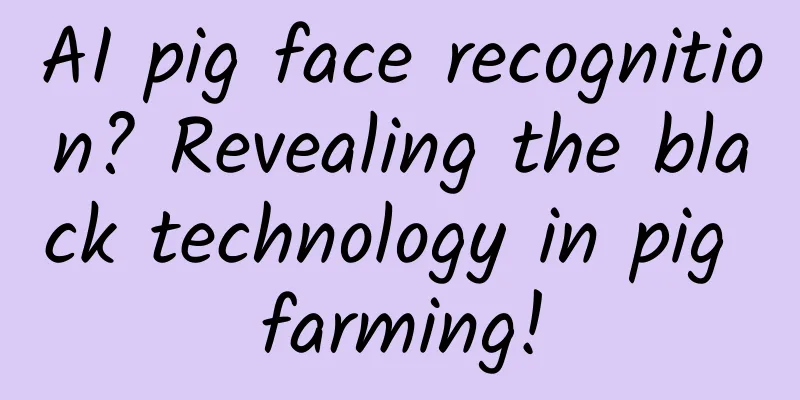AI pig face recognition? Revealing the black technology in pig farming!

|
Author: New Media Center of Institute of Physics, Chinese Academy of Sciences Reviewer: Luo Huiqian, Researcher, Institute of Physics, Chinese Academy of Sciences What is your first reaction when you hear the word "pig farm"? In a remote suburb, there is a fenced area with many piglets kept in it. The breeder comes over with a large basket, picks up a spoon, and sprinkles feed into the wooden trough. The piglets then grunt and squeeze forward, sticking their noses out to snatch food from each other? It seems that in our traditional concept, pig farming is like this, from the messy and dirty environment to the labor of cleaning the pen and feeding, everything is wrapped in the breath of the old times and covered with faded colors like old photos. But what if I told you that many pigs have already lived in smart buildings, and can even eat by scanning their faces and enjoy music massages every day? Isn’t it? I didn’t expect it! In fact, with the booming development of artificial intelligence and the Internet of Things, the domestic pig farming industry is undergoing tremendous changes. In addition to improving the growth environment of piglets, pig farms have also tried a series of black technologies, such as: AI pig face recognition? Wireless radio frequency automatic feeder? Nano-synthetic pig feed...? Next, let us take a closer look at the intelligent pig farm and see how “black” these technologies are. 01 AI Pig Face Recognition Have you ever noticed that piglets of the same breed all look very similar? We must track and record the weight, food intake and other data of each piglet to determine its growth status. However, it is almost impossible to distinguish hundreds of piglets with the naked eye. Therefore, it is necessary to identify each pig. In the past pig farming process, marking was generally done on the pigs' ears, but this method required manual recording of all data, which was very inefficient and prone to errors. In order to solve this traditional dilemma, we thought of migrating the relevant technologies of human face recognition to pig face recognition. However, as mentioned just now, the inbreeding of pigs makes the individuals very similar, which invisibly increases the technical barriers of computer vision algorithms. Therefore, pig face recognition technology seems like a dream. What is surprising is that in recent years, with the development of deep learning technology, the pig face recognition algorithm has finally made a qualitative breakthrough, and some large farms have even begun to introduce pig face recognition systems. So, how does this pig face recognition system, which sounds so magical, actually work? First of all, today's intelligent pig farms will create a dynamic cloud database for each pig, take 2-3 videos of them, extract valid identity information through algorithms, generate a corresponding electronic ID, and store it in the database. This means that these piglets also have their own ID numbers. Isn’t that amazing! After the piglets have their ID cards processed, a track robot needs to be installed on top of the pig house. The robot will patrol along the track at regular intervals and use the camera on the front end to scan and collect the pig's face, convert the signal into a digital signal, and use the convolutional neural network algorithm to extract the important features of the pig's face. The robot then matches the pre-stored pig face information to select the set of data with the highest degree of fit, thereby determining the final electronic ID. In this way, it is possible to identify which piglet it is. After identifying the piglet, various sensors are used to record the piglet's weight, body temperature, food intake and other information, which is automatically uploaded to the cloud. Some important values are displayed on the central control panel, thus achieving contactless real-time monitoring. In August 2018, African swine fever broke out in my country for the first time, and its impact continued to spread. Hundreds of millions of piglets were infected and died. Many pig farms were on the verge of bankruptcy. What is even more worrying is that the vaccine is still under development and African swine fever has not yet been completely resolved. At this critical moment, some large pig farms made a bold attempt and introduced pig face recognition technology. After manually setting the thresholds of parameters such as body temperature and food intake, the system automatically identified piglets with abnormal body temperature and loss of appetite, and then the central control panel automatically sounded the alarm. After the staff saw the red warning, they could isolate and test these piglets marked with "yellow code" as soon as possible to determine whether they were really infected with the plague. Therefore, to a certain extent, the price of pork has gradually returned to normal, and pig facial recognition has also contributed to this. 02 Wireless RF Due to the high technical threshold, the introduction of a complete set of pig face recognition technology requires a lot of capital investment, so it has not yet been widely used in pig farms. However, the wireless radio frequency technology to be introduced next can be said to be relatively mature, and you may have heard of it. After all, as early as the beginning of the 21st century, it was widely used in logistics management, traffic monitoring and other fields. However, for pig farming, it is still a relatively new thing. Generally speaking, the most basic radio frequency identification (RFID) system mainly consists of two parts: radio frequency card and reader. The radio frequency card contains a chip for storing identification information and data, and the chip is connected to an antenna. The reader includes a transceiver antenna, a transceiver module and a control circuit, which can radiate electromagnetic waves outward in a specified area. When the radio frequency card passes through the area, it will receive the electromagnetic waves emitted by the reader and generate an induced current, and transmit the stored coded information to the reader in the form of radio waves. The reader demodulates and decodes the received signal and sends it to the central management server. Based on this wireless radio frequency technology, major pig farms have begun to introduce various automated equipment. Let’s take the automatic pig feeding equipment as an example to see how it works. First, you need to pierce holes in the ears of each piglet and wear an electronic ear tag, which is the "radio frequency card" mentioned above. Then, when the piglet needs to eat, it enters from the entrance of the feeding positioning fence and comes to the automatic feeding device. After sensing the approach of the piglets, the card reader above the device will automatically read their electronic ear tags, extract the identity information of the pig, and feed it back to the central manager. The system will issue instructions to the automatic feeding device based on the physical data record of the pig, and feed a specific type and amount of feed to the piglet. After the piglet finishes eating and goes out of the positioning fence exit, the system will automatically identify the remaining weight in the trough, calculate the amount of food the piglet has eaten, and then upload the record. A careful comparison will reveal that this is similar to pig face recognition. The key point is to find a way to identify the piglets and record the relevant data, but the investment cost of wireless radio frequency technology is much lower. However, since electronic ear tags need to be implanted in the pigs' ears, this can easily cause discomfort to the piglets. Just like dogs always like to rub against corners and take off the small clothes we put on them, it is not uncommon for piglets to wear and bite off the labels, and in severe cases, it may cause local ear infection. If the method of implanting electronic tags in piglets still has some of the disadvantages mentioned above, there is no such concern at all when using wireless radio frequency technology in the process of pig feed processing. In other words, even the feed that pigs eat is now fully automated using radio frequency technology. In traditional feed processing plants, multiple employees are generally required to register and weigh each raw material on the assembly line and feed it into the instrument for processing and synthesis according to the proportion. This is not only time-consuming and labor-intensive, but also difficult to accurately grasp the amount of feed. Serious misoperation may lead to risks such as dust explosions. (Schematic diagram of RFID application in pig feed processing) Nowadays, using wireless radio frequency technology, each raw material can be matched with an electronic radio frequency card, and a reader can be installed in the feeding bin. When the raw materials enter the feeding bin, the raw material information is automatically read and the metering scale is assigned. Mixing and processing are carried out according to the formula requirements, and finally the packaging and labeling are automatically printed, and the results are uploaded to the database. Since each raw material has its own electronic ID and each step has data records, if there is a problem with the feed in the end, it can be traced back to the source by querying the processing records, realizing intelligent risk control. 03 Nanosynthesis Since we are talking about feed processing, we have to talk about the current "nano-grade pig feed". That's right, pig feed is no longer the yellow powdery and rough particles it used to be. Many feed additives have been integrated with nano-synthesis technology, especially vitamins, and the particle diameter can reach hundreds of nanometers. Piglets need various vitamins for their healthy growth, so vitamins are an indispensable additive in pig feed formulas. However, general vitamins are easily oxidized and hydrolyzed in the air, and their utilization rate in the end absorbed by sows is very low. Experimental studies have shown that nano-scale liquid vitamins are more easily absorbed, which can significantly improve the reproductive performance of sows and improve the quality of pork. During the processing of this nano-scale liquid vitamin, nanotechnology and microemulsion technology are mainly used. At the same time, a biomimetic membrane composed of phospholipids, cholesterol and protein is used to instantly embed the vitamins in the biomembrane to form a self-assembled structure with a particle size of 30-100 nanometers. Due to its excellent biological affinity, the nano-scale vitamins can be quickly absorbed across the membrane and improve the utilization rate. In order to verify whether the vitamins in current pig feed have really reached the nanoscale, the editor contacted a feed manufacturer and obtained two vitamin samples, namely nano preparations and ordinary emulsions. Theoretically, the differences between the two are mainly as follows: The Tyndall effect refers to the following: when visible light with a wavelength in the range of 400-700nm passes through a colloid with a diameter of about 1-100nm, the light beam is scattered by the particles suspended in it, causing the light to propagate in all directions. Thus, a bright "pathway" can be observed in the colloid from the direction perpendicular to the incident light. In simple terms, the scattering of light in the colloid makes the light path "visible". Based on this principle, we first use the Tyndall effect to simply verify it. The following are the experimental comparison results: (Comparison of Tyndall effect experiments) The milky white one on the left is ordinary vitamin emulsion, and the light yellow one on the right is nano-scale vitamin aqueous solution. When we use a red laser pen with a wavelength of 650nm to irradiate these two samples, an obvious complete light path appears in the nano-scale liquid vitamin, and a light path also appears in the ordinary emulsion, but the light path is short and unclear, and the light transmittance is relatively poor. The reason is that their particle size is larger, which hinders light more, so the light path is very short. From this, we can preliminarily judge that the particle size of nano-scale liquid vitamins is about several hundred nanometers. In order to make a more accurate judgment, we made special sample preparation for the sample, and then observed the morphology of the particles under a scanning electron microscope. The SEM scan image obtained is as follows: The left picture uses a relatively small magnification to observe the sample morphology in a large field of view. The unit scale is 0.5 μm. It can be found that the diameter of the particles circled in the red frame is below 500 nanometers. In order to determine its diameter more accurately, we zoom in on this area and obtain the right picture. The unit scale is 0.2 μm. The diameter of this particle is about half a scale, which is about 100 nanometers. This shows that the so-called "nano-grade pig feed" is indeed worthy of its name and is not just a sales gimmick. Now, I believe everyone’s impression of pig farming must be very different! In this way, the scene of the old man bending over, picking out shriveled corn kernels under the grape vines, mixing them with the leftovers at home and putting them into a bucket, and staggering towards the pigpen will inevitably become farther and farther away from us, and will eventually be frozen in yellowed old photos, branded with a unique mark of the times. Maybe you will sigh at the passing of an old era, or maybe you will look forward to the arrival of a new era. It is difficult for us to explain how complex our emotions are towards such technological development, but perhaps this is the essence of life. Let’s imagine what the pig farms of the future will look like. Maybe there will be small aircraft carrying piglets flying in the air? References: [1] Qin Xing, Song Fangfang. Pig face recognition algorithm based on bilinear convolutional neural network[J]. Journal of Hangzhou Dianzi University (Natural Science Edition), 2019, 39(02): 12-17. [2] Jiang Jiasheng. Discussion on wireless radio frequency identification technology [J]. Science and Technology Information (Science Education and Research), 2007(27):312+532. [3] Li Jiao, Jia Hongru, Wang Yuan, Guo Xiaohong. Effects of different dosage forms of vitamin complexes on pork quality[J]. Animal Husbandry and Veterinary Science and Technology Information, 2020(09):41-42. [4] Sun Haixia, Xue Ru. Composition and working principle of RFID system [J]. Tibet Science and Technology, 2005, (09): 59-60. This article is produced by Science Popularization China-Starry Sky Project (Creation and Cultivation). Please indicate the source when reprinting. |
<<: Is a child's laughter a disease? Be careful of this tumor!
>>: Is there a healthiest snack that won’t make you fat? Yes and no
Recommend
How much does it cost to make the Dali ticketing mini program? What is the quotation for making Dali ticketing mini program?
There are two types of Dali Ticketing WeChat Mini...
Brand marketing: 15 common consumer psychology and corresponding marketing strategies
There are many kinds of consumer psychology, and ...
Will the "smart" gimmick of home appliances win the day? The dispute between the two factions has started again
"I don't think any of the so-called smar...
How to start promotion from scratch?
From Internet to Mobile Internet At a time when s...
Companionship growth training camp
Companion Growth Training Camp Resource Introduct...
First discovered by Huygens in 1665, now a higher-order network synchronization has been discovered
A study led by Queen Mary University of London ha...
Xu Xian's favorite "Suzhen", scientists went through hardships to discover it
After years of investigation and sample research,...
iPhones frequently freeze to death! Why are Android phones not affected?
Recently, many netizens said that their iPhones ha...
It seems like the Milky Way falls from the sky - some knowledge about the mechanics of waterfalls
Waterfalls are always associated with amazing sig...
The jokes will make you understand what Internet thinking, big data, O2O, crowdfunding, red ocean and blue ocean are in seconds!
[[145188]] What is big data? The phone rang at a ...
How much do you know about the information flow advertising routines of highly profitable products?
After reading this article, I hope you can improv...
"Tiangong Classroom" is about to start. What are the tricks of China's first space class on the space station?
Latest news! China's first space science educ...
Gu Yue "Next Generation Game Props Production"
Course Catalog ├──Chapter 1: Middle Model Constru...
Analysis of practical cases of advertising in the education and training industry
What should I do if I want to increase the number...
Electric Technology Car News: With its stunning appearance and low price, can Trumpchi GS3 successfully enter the small SUV market?
GAC Trumpchi has been very successful in the SUV ...









